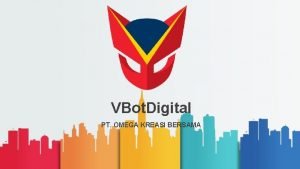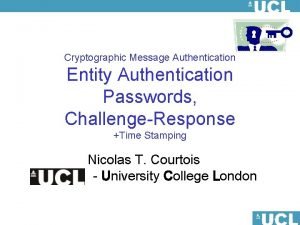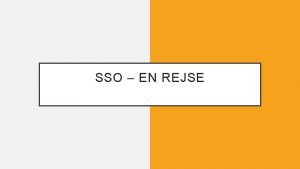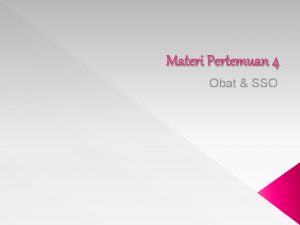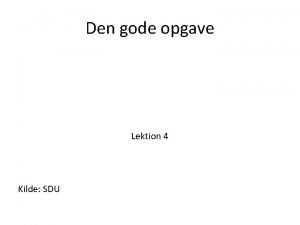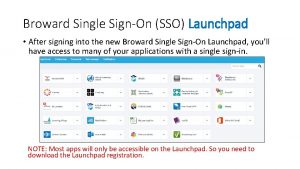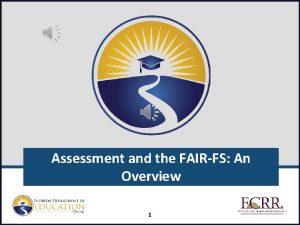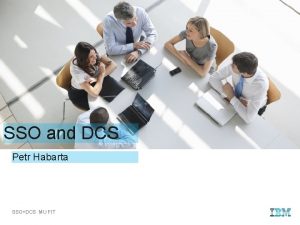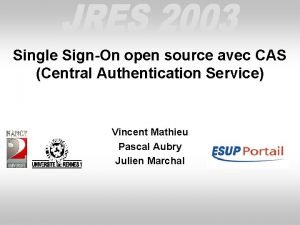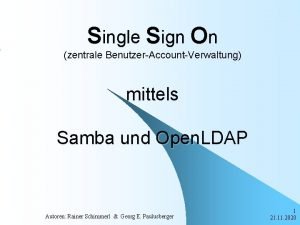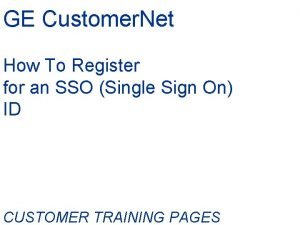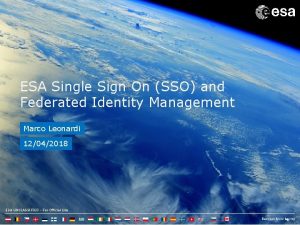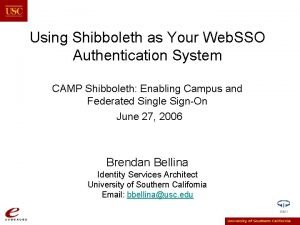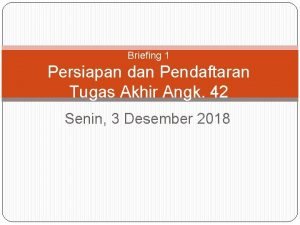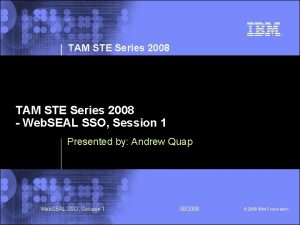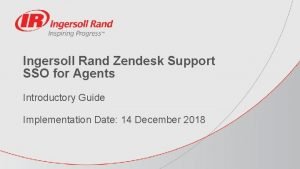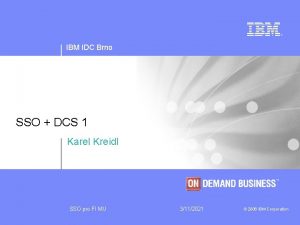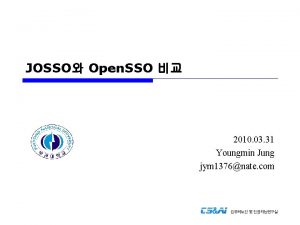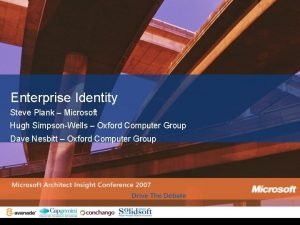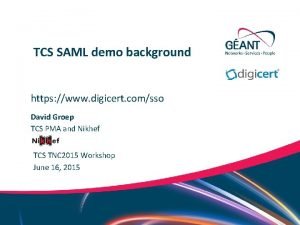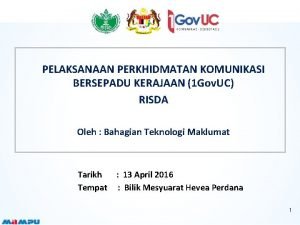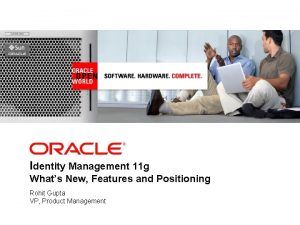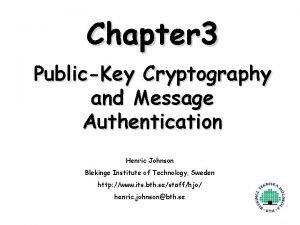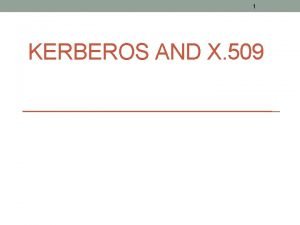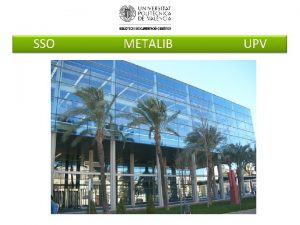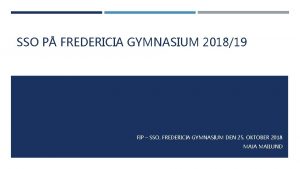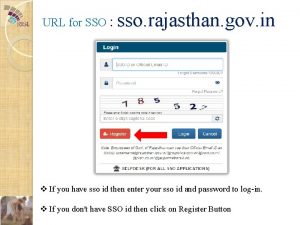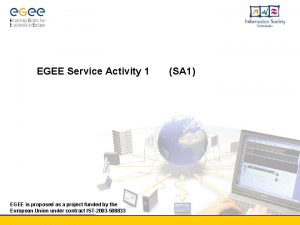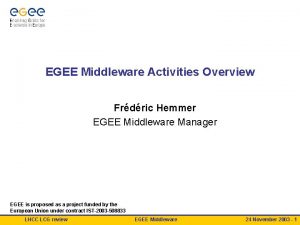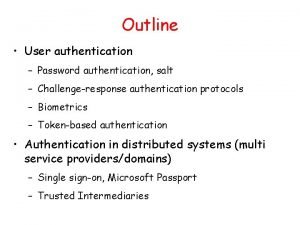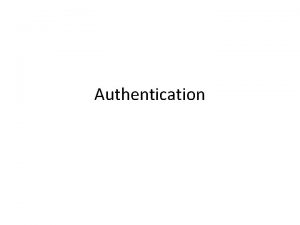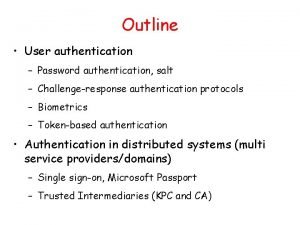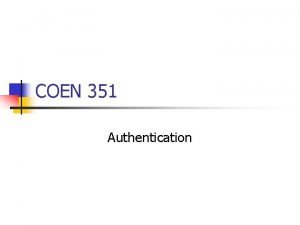Portal Authentication and SSO EGEE portal authentication workshop












































- Slides: 44

Portal Authentication and SSO EGEE portal authentication workshop CERN, 2 -3 May 2007 Jensen STFC RAL <j. jensen@rl. ac. uk>

Contents • Single Sign-on, where art thou? • Credential Conversion – Hereinafter “CC” • Portals in NGS • SSO with a Real Life™ Alternative to Portals • Robots in UK e-Science CA

SSO Or how I learned to stop worrying and start loving the Grid

Five steps to SSO 1. Account management: each user has a single registration 2. Single password: a single password is used to unlock all resource accounts 3. Single authentication – each user must type the password only once • Per day, per week, per login

Five steps to SSO 4. Credential gymnastics - CC • • • GT 2 delegated proxies Accommodate thin and thick clients Support legacy apps 5. Delegation • (beyond scope of this talk)

CC goals – web based • If on-site, use federal id (Active Directory/Kerberos) • If off-site, use certificate – if loaded into browser • Otherwise username/password – Same as fed username/password – Not allowed to store password… • System must know these are the same

Web (HTTPS) based SSO • Easier to implement servers – Apache can do Everything™ – Not always trivial to integrate with existing portals – Apache vs Tomcat, String. Beans, u. Portal, CHEF, SAKAI, …(insert portal framework du jour) • Lots of HTTP tools that understand security • Future proof, when UK goes to Shibboleth

Credential Conversion Or how I learnt to stop worrying about one thing and start worrying about another

My. Proxy • My. Proxy useful for SSO to Grid – Because Grid requires X. 509 certs • Call out to site authentication – For username/password maintenance • Investigating new My. Proxy+PAM

Status – Users • Need certificates for Grid work • Using e-Science certificate – Once every year, obtain/renew cert – Once every week, renew proxy • Upload tool in Java, another in python – Once every day • Log in to Windows (or Linux kinit) • Or, …

Status - Users • Or, have My. Proxy generate the certificate – Using built-in CA – Trust issues – My. Proxy is local (SSO), or, in any case, not an accredited CA

Status – software • Prototype portal (python) – Thin clients (web browser) – Fetches proxy from myproxy – AD/K 5 works with IE and certain Linux browsers • Components for thick clients – Fetches proxy locally from My. Proxy

Status - Software • Portal framework du jour – u. Portal, String. Beans, – Some easier to SSO than others

Portals and Authentication Or how I learnt to start worrying about my deadlines

Client Side – from outside P O THE GRID R T Certificate A SRB L VOMS (old slide)

Client Side – from within P O THE GRID R T A L Microsoft Active Directory SRB My. Proxy (old slide) VOMS

• SRB provides SSO SRB • But ∫ with everybody else’s… THE • S commands can be GRID used with GSI and with username/password • in. Q doesn’t understand certificates THE BEAM SRB

Authorisation Model • Delegate authorisation? • Need to authorise to multiple resources

Authorisation L D A P Microsoft Active Directory Gridmap file My. Proxy VOMS Corporate Data Repository

Grid AUZ L D A P STFC NGS LCG L D A P

Using Institution Id. P • Puts identity management in institution – That’s good – they do it anyway – That’s bad – the CA has no control • Associate DN with identity • Institute does not (usually) release information • Institute does not describe vetting policy – So lower assurance then…

Using Institution Id. P • Solves scalability problem • Shibboleth does this too! – Why not use Shibboleth then? • We do! – Shib. Grid (not to be confused with Grid. Shib) – SHEBANGS

Comparing CC to Shibboleth • • • Complementary – coexist with Shib Simpler – no need for attributes (at this level) Simpler – used only to access Grid Simpler – no WAYF but on site only Joining is infinitely cheaper – Driven by the NGS Grid, not institution – Some similar data protection issues

Shib. Grid my. Proxy 6 6 Id. P 4 2 WAYF 7 5 7 3 Portal 1 7 The GRID 1 -Upload and download certificates to my. Proxy -(this slide stolen from NG)

SHEBANGS Integrates VOMS attrs into credential (Image from SHEBANGS)

A Real Life™ Alternative to Portals Or how I learnt to stop worrying and get on with my work

Java SSH Term • Written in Java (no, really) – Standalone – untar and run – Or run as an Applet • xterm – Understands (most? ) ANSI control seqs – vi works!

Java SSH Term • Took open source terminal (in sf. net) • And GSISSH plugin contrib’d from Canada • And developed: – Integration with myproxy – Various tweaks and fixes

SRB > echo hello world User Interface WN WN My. Proxy ID database SRM VOMS

Java SSH Term • Can integrate with site Active Directory • Works! • But only with Java 1. 6 – Available now!

On Robots Or how I dream about stopping worrying, and about Laziness, Impatience, and Hubris, too

What is a Robot • A user certificate – Whose private key is “unprotected” – i. e. not protected with a passphrase • Identity – Not tied to a network identity – Tied to a specific user (owner)

Why Robots • Solve certain tasks – Email encryption – Grid monitoring • Different types (extensions) • A 1 SCP policy defines an additional OID

UK Implementation • First one? Now dutchgrid has one too! • Meant to – be accepted by the community – gather real life robot experiences – become Robot HOWTO for others to use

UK Implementation • Robots have names – Name after what they are, not what they do – “Grid. Client”, “Mail. Cipher”, … • What they do… – Depends on use and authorisation – Grid. Client usually does monitoring

Robot Names • Robot DN derived from owner’s DN – Owner DN + an additional CN – /CN=Robot: Grid. Client – ‘: ’ can be encoded as printable. String – ‘: ’ does not occur in user or host CNs – Simple algo to find name of owner of robot

Robot Names • Why use the DN? – DN is used for authorisation – DN is logged into log files – Can easily find user from Robot’s DN • Allow disambiguation – /CN=User Name/CN=Robot: Type (314) – No semantics associated to disamb.

Robot extensions • Must be documented for each type – Documentation can be external to CPS • Allows for adding more types • NO SERVER EXTENSIONS – MUST NOT be able to act as server – Does not contain network identity

How to recognise a robot …from quite a long way away. • Check the DN… – Does it have an add’l CN with “Robot: ” • Check the policy. Identifier – Does it have any Robot 1 SCP OID?

Security Issues • MUST be authorised independently – of the user’s authorisation • Private key is “unprotected” – i. e. , not by passphrase – “always on” • So UK policy requires: – Private key MUST be held on key token • Can’t steal the key, physically held on machine – Proxies MUST NOT be generated from robot

Security Issues • Robot certificates MUST NOT be shared – Single person responsible for use of robot – CA decides what it is, owner what it does • Each Robot has a unique DN – No two Robots share keys – A single Robot only has two key sets when rekeyed

Security Issues – RA • Owner uses existing certificate/key to apply for a Robot • RA op MUST verify that key is protected on key token – Slightly clumsy changes to procedure – Also true when rekeying

Open Questions • Can anyone apply for a robot? – If not, how should it depend on the type? • Distinguish simple from powerful robots – Other than by extns – How to enforce what it does (cf Globus services) • Bit like object signing extensions – How does CA assert this?

Conclusion • Portals can be a good thing • But are just one application among many • Fit in with existing AUC and SSO – Portals can do CC to improve usability – But this has security issues
 Https://cararegistrasi.com/egee
Https://cararegistrasi.com/egee Egee 102 home activity 4
Egee 102 home activity 4 Egee rhone alpes
Egee rhone alpes Peer entity authentication definition
Peer entity authentication definition Iff
Iff Sso informationssøgning
Sso informationssøgning Matematik dispositioner
Matematik dispositioner Bronkhodilator
Bronkhodilator Sso pertanian
Sso pertanian Sso.minfin.gob.gt
Sso.minfin.gob.gt Sdu sso
Sdu sso Broward soo
Broward soo Fldoe sso
Fldoe sso Hisd sso
Hisd sso Sso omfang
Sso omfang Petr habarta
Petr habarta Open source sso
Open source sso Samba sso
Samba sso Fldoe sso
Fldoe sso Gecustomer net
Gecustomer net Esa sso
Esa sso Usc shibboleth
Usc shibboleth Sso
Sso Sso altar
Sso altar Kr26.sso
Kr26.sso Lintar untar sso
Lintar untar sso Sso shriram
Sso shriram Red seals sso
Red seals sso Sso el salvador
Sso el salvador Ssodcs
Ssodcs Sso
Sso Zendesk guide sso
Zendesk guide sso Ssodcs
Ssodcs Eastcoastfeet
Eastcoastfeet Sso database kläder
Sso database kläder Kim josso
Kim josso Hugh hefner
Hugh hefner Wam.fldoe
Wam.fldoe Plone sso
Plone sso Digicert sso
Digicert sso Sso.govuc
Sso.govuc Oracle identity governance roadmap
Oracle identity governance roadmap Authentication in cryptography and network security
Authentication in cryptography and network security Public key cryptography and message authentication
Public key cryptography and message authentication Kerberos x.509
Kerberos x.509
